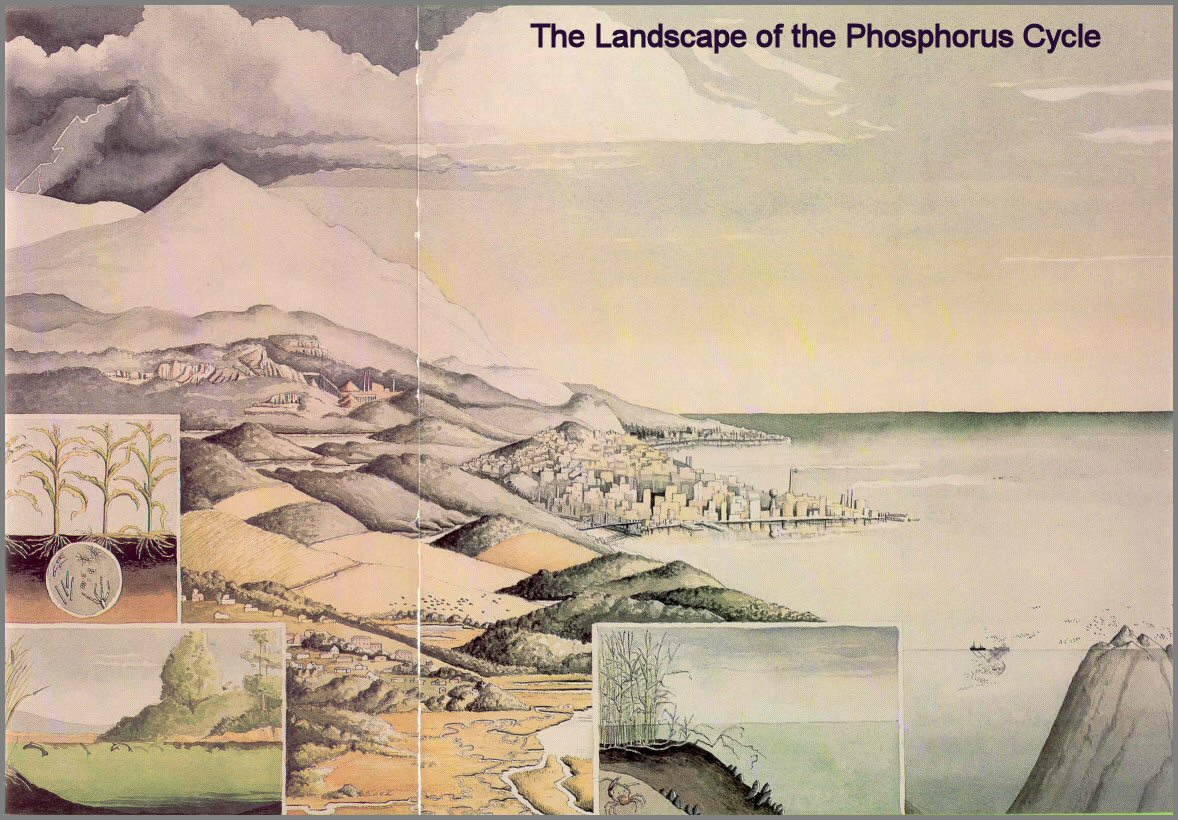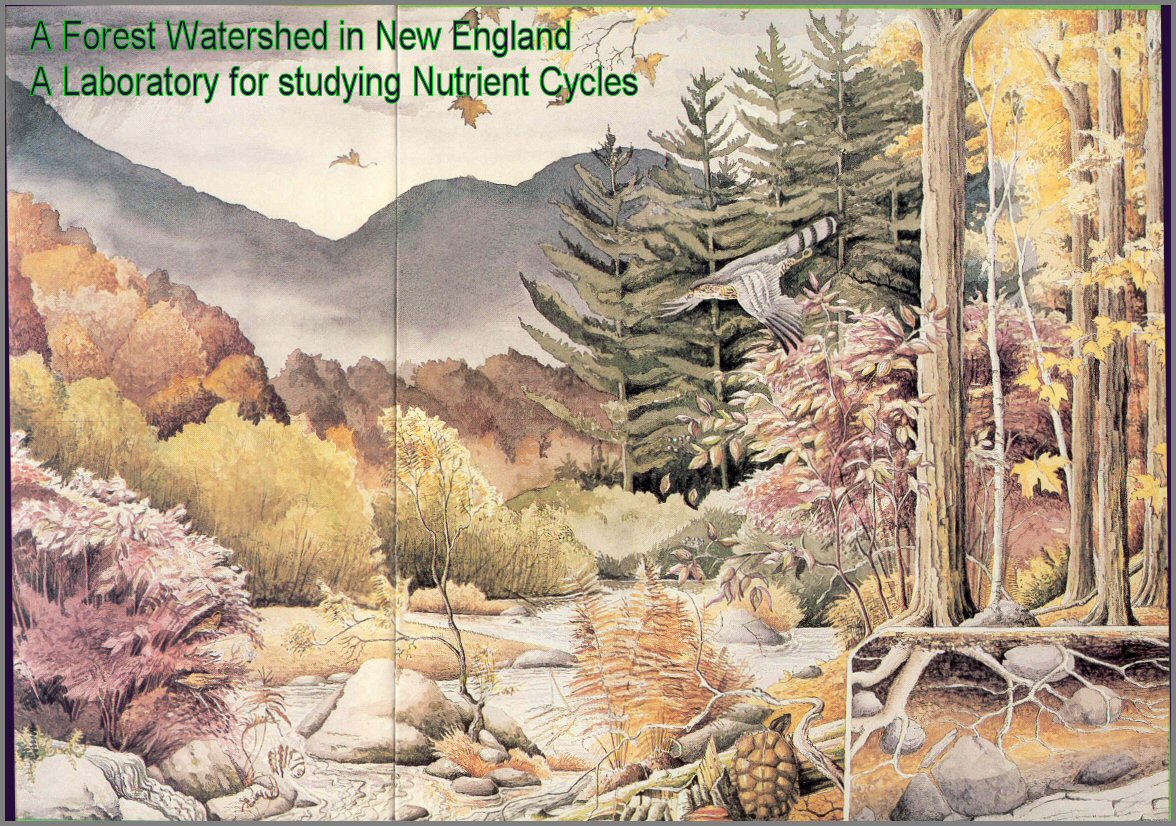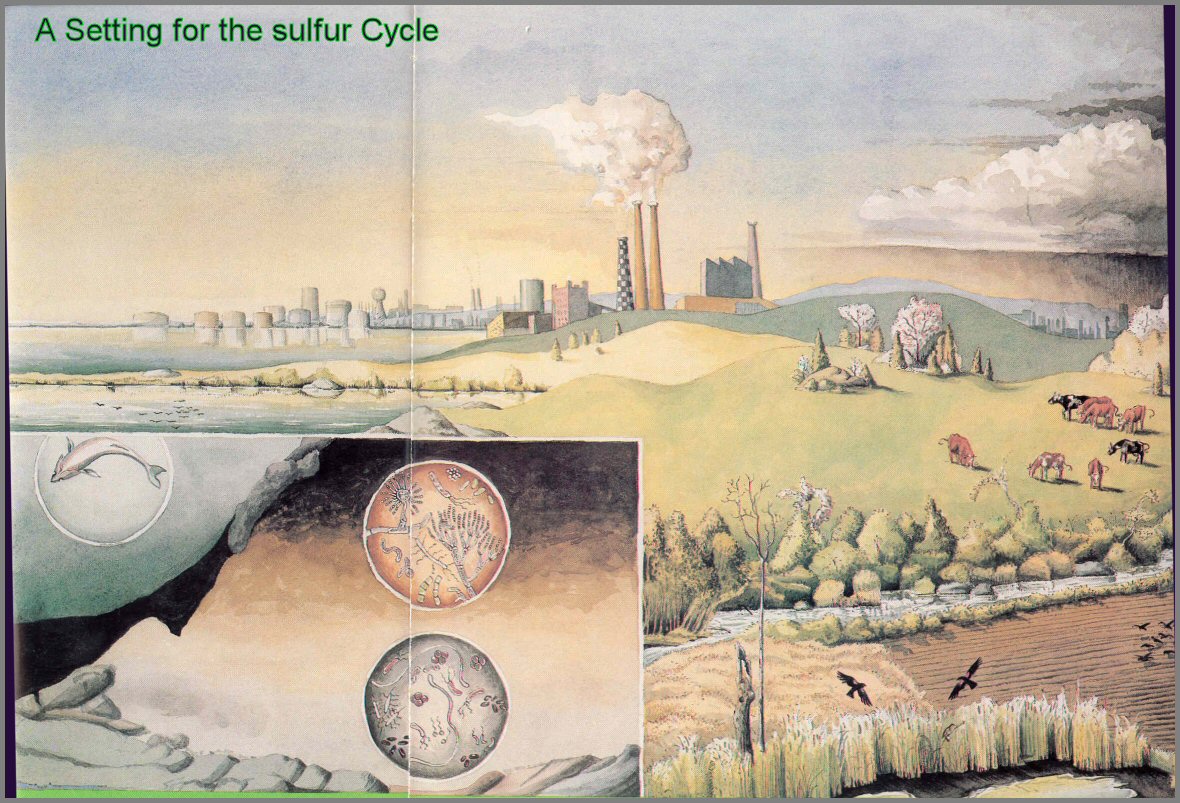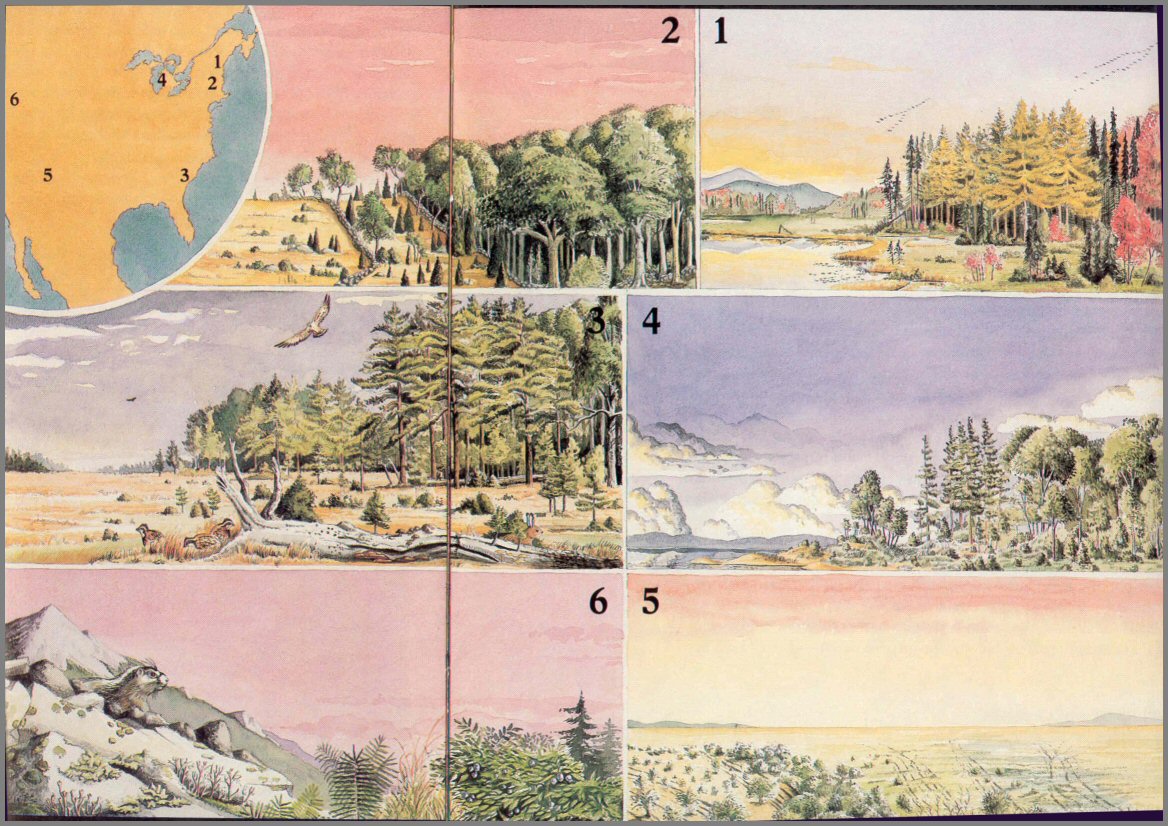
[MA149]Pages 59-87
(It may take a while to download but I think it is
worthy - John A. Keslick, Jr.) A word from the webmaster - Within
this article the word nutrient is misused at times where the true meaning is
essential elements. See my dictionary at
www.treedictionary.com and look up
nutrient as well as essential element. The reason for the latter is to
reduce misunderstanding of terms to better understand the message.
John A. Keslick, Jr.
Figure 18. - The carbon cycle, one of the most important to man, is also known as the carbon dioxide cycle. It can also be considered an oxygen cycle. In this illustration, the biological fixing of carbon dioxide by green plants (photosynthesis) and the transfer of organic carbon to Consumers is shown by green arrows; the return of carbon to the atmosphere (combustion, oxidation, decomposition, respiration) is shown in red. The passive transfer of carbon dioxide between atmosphere and oceans is shown in blue.

Page 59
The nitrogen cycle
Nitrogen is a particularly important element for the health
and well-being of people. Proteins, nucleic acids, vitamins, hormones, and
enzymes that contain nitrogen are required for many essential bodily functions.
Although nitrogen makes up 79 percent of the atmosphere that bathes the earth,
our food supply depends more on the availability of this element in a usable
form than that of any other. The nitrogen cycle (fig. 19) is complex; it
includes the activities of many groups of microbes. It is a marvelous
example of how important microbes are to life itself.
To be used by green plants, gaseous nitrogen (N2) must be
converted or fixed into usable compounds by electrification (lightning),
by industrial processes or by nitrogen-fixing bacteria and algae.
Nitrogen-fixing organisms in soil, water, and especially those in nodules on the
roots of legumes convert gaseous nitrogen into highly soluble salts of nitrates
(NO3-) and ammonium (NH4+) (fig. 19, step 4). Plants absorb these
compounds and convert them into nucleic acids and amino acids and eventually
into proteins. Animals obtain nitrogen as plant- produced amino acids (-
NH2); they use these acids to build protein and other molecules.
Figures 19, 50, and 52 also show some of the ways that people
influence the nitrogen cycle. Internal combustion engines emit nitrous
oxides; huge quantities of nitrate and ammonium salts are produced and applied
as fertilizers; tremendous amounts of nitrates are concentrated in animal and
human wastes; and human activities result in increased erosion and runoff of
nitrates into streams, lakes, and rivers.
The nitrogen cycle continues as protein from dead animals and
plants is converted by decomposer organisms back into ammonium salts and ammonia
gas (NH3) (fig. 19, steps 1 and 3); this cycle is completed by other groups of
bacteria that convert these compounds into nitrite ions (NO2 - ) or into
atmospheric nitrogen (fig. 19, steps 2 and 5).
Page 60
Figure 19.- The complex nitrogen cycle is a marvelous example of how microbes are important to life itself (parts of cycle illustrated by red or green arrows); this cycle also includes abiotic processes (blue arrows).

Page 61
This complicated cycle also includes bacteria that can
reconvert the nitrite ions to nitrate ions for use by plants (fig. 19, step 2).
Some nitrogen is lost from the cycle when dissolved nitrates are leached (washed
out of soil) into streams, rivers, and finally into the deep sediments of the
seas; this loss is probably balanced by the nitrogen that reenters the air in
volcanic gases.
The microbes and higher organisms that convert nitrates to
proteins acquire their energy from other organic matter or from the sun (fig.
19, green arrows), while those specialized groups of bacteria that reconvert
proteins to nitrates derive their energy from the chemical degradation process
itself (fig. 19, red arrows). The inserts in figure 20 illustrate the major
microbial forms involved in the five steps of the nitrogen cycle.
Page 62
Figure 20. - Some representatives of the many groups of microorganisms, primarily bacteria, that are involved in the five steps of the nitrogen cycle.

Page 63

Page 64-65
The phosphorus cycle
Phosphorus is an element of major significance; it is a
necessary component of the protoplasm of every living cell. As part of
adenosine triphosphate (ATP), phosphorus plays a key role in the storage and
supply of energy, and it is an important component of the nucleic acids DNA and
RNA. Phosphorus is also a major component of bones and teeth.
The cycling of phosphorus through several ecosystems is shown
in figure 21. This is a sedimentary cycle-the reservoir pool is in rocks,
in deposits of fossilized bone formed in past geological ages, or in great beds
of sea bird excreta, or guano, on islands near Peru.
The weathering of these deposits, sometimes hastened by
mining, releases phosphates-usually inorganic orthophosphate compounds (PO4---)-
into soil or aquatic ecosystems where they can be absorbed by the green plant
Producers and used in synthesizing protoplasm. Herbivore Consumers obtain
much of this phosphorus when they eat plants. When plants and animals die,
the decomposer Consumers return the phosphorus to soil or water as dissolved
Organic Compounds. Excreta from animals, including people, contribute
organic matter rich in phosphorus to soil and water systems. Bacteria then
break down these Organic Compounds into inorganic phosphates that reenter the
cycle.
Page 66
Figure 21.- The paths along which phosphorus moves through ecosystems from rock and guano deposits to the sea (red arrows) and back to land again (blue arrows). Along the way, phosphorus is cycled between the living and nonliving Players (green arrows).

Page 67
Figure 22. - Eutrophication or aging is speeded up when too much phosphorus "leaks" into fresh water bodies.

Figure 23.-Phosphorus cycles rapidly between water, sediments, and shellfish in the salt marsh ecosystem.

Page 68
Considerable quantities of phosphorus "leak" into waterways and eventually
are deposited in shallow marine sediments. Along the way, excessive
amounts of dissolved phosphates from sewage treatment systems and from farm
feedlots can cause "traffic jams" of phosphorus. An excess of phosphorus
in water causes an increase in plant life and an increase in the natural process
of aging in ponds or lakes, call eutrophication (fig. 22).
Upon reaching the shallow salt marsh estuary ecosystems,
phosphates are cycled rapidly between the sediment reservoir and the detritus
reservoir (fig. 23, insert). Phosphorus absorbed from deep marsh sediments
by the marsh grass Producers is released from the dead grass detritus (see page
29 for a discussion of detritus) by Consumer detritus feeders (for example,
fiddler crabs), is absorbed and accumulated by Consumer filter-feeding organisms
(ribbed mussels), and is released again to the water and sediments for recycling
by the grasses. These estuary systems are the repository of most soil and
other matter removed from the land and carried in streams. They act as
"nutrient traps" and are very sensitive to the pollution that often arises from
activities far away.
Page 69
Figure 24. - Large quantities of phosphorus are flushed down rivers and reach the sea.

Figure 25. - The large amounts of phosphorus returned to the land by fishing or by birds is far exceeded by losses to deep marine sediments.

Page 70
Large quantities of phosphorus are lost from the "nutrient trap" estuary arena or are deposited more directly by rivers to the open waters of the oceans (fig. 24). Here, phosphorus may be cycled by phytoplankton Producers through several food levels or it may be "lost" to the deep marine sediments.
Large amounts of this nutrient are returned to land each year by fishing activities or are deposited on islands as guano of fish-eating birds (fig. 25). But the losses to deep sediments each year exceed by many thousands of tons the amounts that are returned to land.
Page 71

Page 72-73
Figure 26. - The calcium flowing out of a New England watershed (blue arrow) was balanced by that entering this ecosystem through rainfall and through weathering of parent bedrock (red arrows). The figures are given in kilograms per hectare per year. The green arrows show the amount exchanged each year between soil and plants.

Page 74
The concentration of elements in an ecosystem at a given point in time gives only a limited view of their importance. The study of the "turnover" and distribution of nutrients-of the fate and whereabouts of essential materials- can greatly help our understanding of what is going on around us. This is illustrated in the following discussion of the calcium cycle.
The calcium cycle
Calcium is another element of vital importance. In plants it is a major
component, as calcium pectate, of a thin layer that "cements" cell walls
together; in animals, calcium is the primary component of bones, teeth, and
shells. The large nonliving reservoir of calcium is located in the rock
sediments.
The rates of exchange of calcium between the nonliving and
the smaller living reservoirs were determined for some northern New England
watersheds (a watershed includes the stream and all the land over and through
which water drains into the stream). Figure 26 shows that the cycling of
calcium was so "tight" in this forest watershed that only about 8 kilograms (kg)
of calcium per hectare (ha) (about 7 1b/acre) left the ecosystem annually by
means of the stream. Since 3 kilograms per hectare of calcium (2.67
lb/acre) entered the watershed in precipitation each year, the amount needed to
"balance" the loss, 5 kilograms (4.5 lb), was obtained from weathering of the
rock reservoir.
The active flux of 50 kilograms per hectare (about 45
1b/acre) per year between the soil and plants is made possible by trees and
shrubs, such as sugar maples and dogwoods, that remove calcium from deep layers
with their roots and deposit their calcium-rich leaves on the upper soil layers.
When streamflow was increased by cutting vegetation and suppressing the regrowth
in a portion of the watershed, the tight nutrient cycle was greatly modified.
Losses of mineral nutrients in streamflow, including calcium, increased 3 to 15
times.
Page 75

Page 76-77
The sulfur cycle
Sulfur, an essential component of certain amino acids, is incorporated as sulfates into proteins by the green plant Producers. Its cycle is a good example of one that bridges air, soil, and water (fig. 27). It includes both a sedimentary pool and a smaller atmospheric pool; and it illustrates again the importance of microorganisms in converting an element from one form to another. The sulfur cycle also directly affects the phosphorus cycle because phosphorus is made available to plants when iron sulfides are formed in sediments.
Figure 27. -As sulfur cycles through the biosphere, it occurs in many forms.

Page 78
The microorganisms in figure 28 are representative of
those that convert one form of sulfur to another. Those in the shallow
sediment (upper circle) are aerobes (operating in the presence of and adding
oxygen), while those in the deeper sediment (lower circle) are responsible for
anaerobic reductions (removing oxygen). Some of these anaerobes are
especially important because they reduce sulfates (SO4)
to hydrogen sulfide gas (H2S) which,
as it moves upward, makes sulfur available to other organisms in the shallower
sediments of the ecosystem.
The sulfur cycle is becoming increasingly important because
it is being affected adversely by human action. The burning of fossil
fuels that contain sulfur has caused a dramatic increase in the amount of sulfur
dioxide (SO2 )in the atmosphere in
some areas (see page 131).
Figure 28.-Fungi and bacteria of the sulfur cycle: aerobes in the upper circle, anaerobes in lower circle.

Page 79
IV. CHANGING PLAYERS AND PLAYING FIELDS;
ECOLOGICAL SUCCESSION

Each of the six inserts shows, from left to right, vegetational changes over time. The changes illustrate how some ecologist believe succession has proceeded in some specific situations. More details are given in the following pages. In most cases, there are other successional "pathways." Indeed, it is unlikely that any two Arenas are exactly alike in the rate or nature of their biotic development.
Page 80-81
We discovered earlier that all ecosystems are governed by the same
rules of energy flow and material cycling and that each ecosystem contains
Players in the Game of the Environment with roles parallel to those in the other
ecosystems. When ecosystems are left to their own devices to follow the
Rules of the Game, each will continue to change-to develop and mature-in a
relatively orderly and predictable way. This process of changeover time,
called succession or biotic development, results when the living
Players, especially plants, interact with and modify their environment.
Plants modify their environment in very complex ways; this modification can be
physical or chemical, and plants present at one point in time even can render a
Playing Field unsuitable for themselves and more favorable for other plants that
eventually may replace them.
The pace of succession varies greatly. Where
environmental factors are favorable and when seeds of plants of later stages are
available, succession proceeds rapidly until plants and their environment are
essentially in equilibrium- then further change is very slow. This
relatively "stable" situation is sometimes called the successional climax.
When moisture or nutrients are limited by geology, topography, or climate,
succession may be imperceptible-it may even be held in check.
SOME EXAMPLES OF SUCCESSION
Northern pond
The northern boreal pond in figure 29 is slowly evolving into a bog, and it
may eventually be a northern swamp forest of red maple, spruce, fir, and larch.
In some cases, it is even possible for succession to continue until an upland
forest with birch and maple develops. Vegetation in the pond begins as
pioneer sedges colonize the water's edge and sphagnum moss develops into a
floating mat along the shoreline. As the moss grows, dies, and collects
organic debris, a few forbs begin to grow on it and in it, adding to the
nutrient base. Later, trees such as larch, red maple, and black spruce
grow, the pond fills in, and the pond becomes a sphagnum bog. As organic
matter continues to accumulate and the bog dries, the trees develop further and
the bog becomes a swamp forest.
Page 82
Figure 29.-Succession causes a northern pond (left) to change into a sphagnum bog (center foreground). The bog may then become a relatively stable swamp forest of red maple, spruce, fir, and larch (center background). A forest of northern hardwood trees may eventually develop here.

Page 83
Old field
Classic old field development or succession in New England is shown in figure 30. Abandoned farmlands are invaded by pioneer grasses and forbs, and by woody species such as redcedar and black cherry. Tree species such as oaks, which may make their appearance early, usually become dominant later. These species then may give way, especially on moist, cool sites in northern New England, to the more shade tolerant species - sugar maple, yellow birch, and American beech. Successional development from a plowed field to a relatively stable forest requires about 200 years when conditions are favorable.
Figure 30. - Old field development or succession in New England begins when abandoned fields are invaded by grasses, forbs, and woody plants such as black cherry and redcedar (left and center); it terminates in a dense forest of hardwood trees (right).

Page 84
Old field succession in the Southeast (fig. 31) typically passes from communities of grasses and shrubs to loblolly pine, and finally to a relatively stable forest of pines, oaks, and hickories. This process requires 150 to 200 years. This is a good example of secondary succession - development that occurs after an established community has been removed or partly destroyed. Succession where no organisms existed previously is called primary succession.
Figure 31. - Old field developments in the Southeast includes grass and shrub communities (center foreground), pines (background), and sometimes terminates in a forest of mixed pines, oaks, and hickories (far right).

Page 85
Lake Michigan sand dune
Figure 32, an example of primary succession on sand dunes along Lake
Michigan, demonstrates the powerful ability of vegetational communities to
modify a harsh environment. As the lake retreated and became smaller over
thousands of years, a series of sand dunes was successively exposed.
Studies of these dunes have shown that, beginning with bare sand (1), different
communities develop - beach grass (2), shrubs (3), cottonwood (4), jack pine
(5), and, finally, an oak forest (6). Primary succession is much slower
than secondary succession; in this example, the process may require about 1,000
years.
Figure 32. -It takes about 1,000 years for vegetational communities to colonize newly exposed sand beaches (1) of Lake Michigan and finally develop into an oak forest (6). On successively older dunes, plant communities change from grass (2), to shrubs (3), to cottonwood (4), to jack pine (5), and, finally, to the oak forest.

Page 86-87